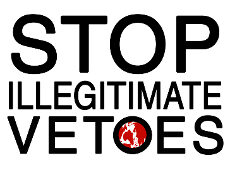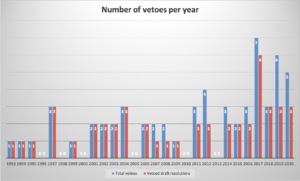2020 in vetoes – failing digital negotiations and outright blocking of action during a health crises
2020 was an exceptional year in many ways, including what transpired at the UN Security Council. Due to the Covid19 pandemic, meetings were moved online and procedures had to be adapted. The digital format has certainly not helped the negotiations in the council, and we have seen a total of five vetoes this year on three draft-resolutions. Although this is one veto less than the year before, it is the same number of vetoed draft-resolutions and the overall trend remains clear; we still have a highly divided Security Council that does not step up to its task to maintain international peace and security.
As in previous years, the most controversial issue was the situation in Syria. Four of the five vetoes were cast regarding humanitarian aid delivery mechanisms in the country, which has also been vetoed previously, including at the end of 2019. The vetoes regarding Syria are more closely described in a previous analysis, but they are revealing in several ways. The back and forth of draft resolutions that have either been vetoed or not adopted made a process visible that usually stays hidden in negotiation rooms; It illustrates that fair negotiations are simply not possible as long as the veto is ruthlessly used. Russia and China had taken the decision to cut down the number of border crossings to one and there was nothing the other members of the Security Council could do about it, even though the clear majority wanted to keep at least the two existing border crossings open. In the end it is again the Syrian people that have to bear the consequences in this desperate situation that has been made even worse by the pandemic.
Only a short time after the four Syria-related vetoes, the next veto came along which would have given guidelines on the treatment of foreign terrorist fighters. This case was also remarkable in several ways. It was the first US veto unrelated to Israel since 2002 and it is the first time that a draft resolution not pertaining to a specific geographic area is vetoed. Instead, the draft resolution mainly contained non-binding language regarding the treatment of terrorists independent of a specific situation. The stated reasons which made the USA veto are also highly unusual. The main critique was that the measures did not go as far as the USA would have liked, since it did not call upon states to repatriate terrorists and their families. This veto led to interesting discussions in our group, on whether the absence of a measure in a draft resolution can pose a threat to sovereignty or security – we think not.
Although these are all the visible vetoes of the year, there is one more situation that should be mentioned. It is not only when a veto is actually cast that P5 countries are misusing their veto power; threatening to veto a resolution can have the exact same effect. Those veto threats are however a lot harder for us to discover, since there often is no paper trail for us to follow, which is why we and many others like to call these instances for “hidden” vetoes. We cannot measure how common those hidden vetoes are, but this year there was one example prominent enough to reach our attention. In this specific case, the USA blocked draft resolutions calling for a global cease-fire in the face of the Covid-19 pandemic, because the discussed resolution would mention the World Health Organization (WHO), and in a revised version indirectly referenced “specialized health agencies”.[1] Because of this, it took until July for the Security Council to finally agree on a resolution, which can be summarized as too little too late.
[1] https://www.rfi.fr/en/americas/20200509-us-blocks-un-vote-on-global-ceasefire-resolution-coronavirus
[/fusion_text][/fusion_builder_column][/fusion_builder_row][/fusion_builder_container]


